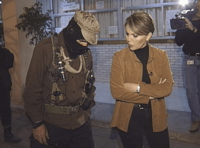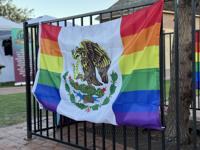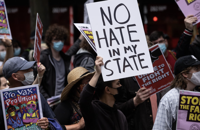
Courtesy of The Smithsonian.
KVEA Channel 52’s evening news anchor Dunia Elvir is one of a handful of Latina journalists who figure prominently in “¡De última hora! Latinas Report Breaking News,” a new exhibit at the Smithsonian Institution’s National Museum of American History in Washington, D.C., that highlights the contributions of Latina journalists in pivotal moments in history.
The Smithsonian says the idea came from another exhibit several years ago, “Escúchame” (“Listen to Me”), which told the history of Spanish-language television through oral histories from TV station employees, and right around the time when two new museums were approved – a Latino one and another focusing on women.
“Our team thought, well, we’ve got both and we proposed looking at Latinas in Spanish-language TV, primarily women who are in front of the camera and who have intersected with significant moments in history,” said Melinda Machado, museum communications director and co-curator of the exhibit. This is the first time the Smithsonian features Latina Spanish- language television journalists.
“From the beginning, Spanish-language stations offered women opportunities to break the glass ceiling in ways English stations did not,” said Kathleen Franz, the exhibit’s project director and chair of the museum’s Work and Industry Division. “By sharing stories about these journalists, we can see how Spanish-language TV gave voice and visibility to a large segment of the American public. As a nation, we cannot understand the history of American broadcasting without the inclusion of Spanish-language TV.”
Elvir happened to be a reporter who covered what has been called the largest-ever immigration demonstration when more than 500,000 protesters gathered in downtown Los Angeles on March 25, 2006, to push for comprehensive immigration reform. Elvir, who arrived in Los Angeles from Honduras as an undocumented immigrant child and grew up in the Watts neighborhood, was at “La Gran Marcha” doing person-on-the-street interviews when a marcher approached her and challenged her to join them, saying, “We know you’re one of us, why don’t you come with us?” Elvir continued to do her interviews, but this time walking with the crowd – all with her 4 ½ high heels and pregnant to boot.
Because the exhibit is part of a museum, the curators were looking for objects to display, and prominently featured are those high heels and a pair of tennis shoes given to Elvir by a viewer who told her they watch the channel to learn Spanish, and came up with illustrations on the shoes of her life – the L.A. freeways (in a nod to her former job as the station’s traffic reporter), the flag of Honduras, and a snippet of Watts, among other highlights.
Another featured object is a jacket belonging to a Los Angeles native also featured in the exhibit and who considers it her “go-to” piece of wardrobe because it travels well and can look professional enough without too much fuss.

The jacket belongs to María Elena Salinas, the former longtime Univisión news anchor who is currently a contributor at ABC News. One of the pioneers in Spanish-language broadcasting in the United States, she wore the jacket during a pivotal news event, interviewing Mexico’s Subcomandante Marcos in 2001.
Also on display is a can of hairspray Salinas donated. Salinas, who got her start in television news at California’s first Spanish-language television station KMEX-TV in Los Angeles, had said it is a significant piece to include because it represents the challenge that Latinas faced – and still do in many cases – with discrimination and sexism even while witnessing turning points in history.
“Latina journalists are always there, covering breaking news,” she says in a Spanish-language video with English subtitles that airs at the exhibit. “Latina journalists still face unrealistic beauty standards, gender discrimination, and different expectations than male reporters. There is still sexism and racism on and off camera. Despite the many barriers Latina journalists on television have broken, there is still a long way to go, but I know we are up for the challenge because our community deserves the highest quality news.”
Machado says the spotlight and homage to these Latina journalists underscores how important Spanish-language media and women reporters in particular are for so many.
“For local Latino communities, their Spanish-language TV stations are vital sources of information and we know that Latina journalists are very trusted by the community,” Machado told CALÓ NEWS.
A recent Nielsen study, “Attitudes on Representation in Media,” found that 72% of Latinos say that it’s very important to watch content in their own language, and 69% of Latino adults say local TV news is a reliable source of information and consider it to be trustworthy. Another study by the International Journal of Environmental Research and Public Health found the issue of trustworthiness to be absolutely crucial in disseminating information during the height of the COVID pandemic. Researchers found that “ethnic news consumption is strongly associated with trust in Spanish-language journalists, whereas mainstream media consumption is not associated with trust in English-language journalists.”
In the exhibit’s video, Salinas alludes to that, saying, “We feel a deep responsibility, not only to inform, but also to help the community understand and navigate our complex reality.”
The moments in history showcased in the exhibit include not only immigration marches and other demonstrations and interviews with prominent newsmakers, but also political debates and wars, among others.
“Latina journalists are advocates for the community,” Machado said.
In addition to featuring several key Latina journalists, the exhibit also includes the work of 19th-century Latinas Teresa Villareal and Jovita Idar, who are considered to be among the first Latinas to report breaking news. Additionally, the exhibit features a section that looks at future trailblazers and includes another Los Angeles journalist, Janette Villafana, a multimedia reporter with L.A. TACO and a graduate of the journalism program at California State University, Long Beach.
“Villafana’s dedication to highlighting the Latino community in Los Angeles and hyper-focus on uplifting the voices and stories of street vendor communities throughout L.A. made its way to Washington, representing our small but mighty independent newsroom,” said L.A. TACO.
The Smithsonian exhibit runs through May 2025.













(0) comments
Welcome to the discussion.
Log In
Keep it Clean. Please avoid obscene, vulgar, lewd, racist or sexually-oriented language.
PLEASE TURN OFF YOUR CAPS LOCK.
Don't Threaten. Threats of harming another person will not be tolerated.
Be Truthful. Don't knowingly lie about anyone or anything.
Be Nice. No racism, sexism or any sort of -ism that is degrading to another person.
Be Proactive. Use the 'Report' link on each comment to let us know of abusive posts.
Share with Us. We'd love to hear eyewitness accounts, the history behind an article.